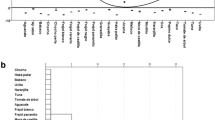Abstract
The bioactive constituents and antioxidant activities of raw, fried and decoctions of cocoyam (Colocasia esculenta) tubers were investigated. The raw form contained considerable amounts of proximates, phytochemicals, minerals, vitamins, amylose, amylopectin and antioxidants (determined from carotenoid, reducing power and 2,2 diphenyl-1-picryl hydrazyl (DPPH) radical scavenging assays). Boiling of C. esculenta resulted in increases (p<0.05) in moisture, carbohydrates, tannins and amylose; significant decreases of fat, ash, protein, carotenoids, thiamine, amylopectin, reducing sugars and DPPH-scavenging activity; insignificant decreases of flavonoids, alkaloids, riboflavin, crude fibre and reducing power. Frying resulted in significant increases in fat, ash, carbohydrate, tannins and amylose; an insignificant increase in crude fibre; an insignificant decrease in riboflavin; but significant (p<0.05) losses of moisture, protein, ash, flavonoids, alkaloids, carotenoids, thiamine, amylopectin, reducing sugars, DPPH-scavenging activity and reducing power. The decreased reducing sugar and increased crude fibre and amylose contents following frying of C. esculenta could be of benefit to diabetics.
Similar content being viewed by others
References
Nwanekezi EC, Owuamanam CI, Ihediohanma NC, Iwouno JO (2010) Functional, particle size and sorption isotherm of cocoyam cormel flours. Pakistan J Nutr 9:973–979
Adegunwa MO, Alamu EO, Omitogun LA (2011) Effect of processing on the nutritional contents of yam and cocoyam tubers. J Appl Biosci 46:3086–3092
Niba LL (2003) Processing effects on susceptibility of starch to digestion in some dietary starch sources. Int J Food Sci Nutr 54:97–109
Gayathri V (2014) Analysis on nutritional values and antioxidant properties of powdered Momordica charantia (bitter gourd) and Colocasia esculenta (cocoyam). Int J Pharm Sci Bus Manag 2:1–4
Chatterjee A, Pakrashi SC (2001) The treatise on Indian medicinal plant. National Institute of Science Communication, New Delhi, p. 32
Mwenye OL, Labschagne MT, Herselman L, Benesi IRM, Chipungu FP (2010) Ethno-botanical and morphological characterisation of cocoyams (Colocasia esculenta L. Schott and Xanthosoma sagittifolum L. Schott) germplasm in Malawi. Second RUFORUM and Xanthosoma sagittifolum L. Schott) germplasm in Malawi. Second RUFORUM Biennial Meeting, 20–24 September, Entebbe, Uganda, pp. 193–199
Kirtikar KR, Basu BD (2001) Indian medicinal plant with illustrations. Oriental Enterprises, Dehradun, pp. 3598–3602
Food and Agricultural Organization (2006) http//www.fao. org/inpho/content/text/ch25_01.htM. Accessed 12/22/2006
Onwuka GI (2005) Food analysis and instrumentation. Theory and practice. Napthali Prints, pp. 140–146
AOAC (1990) Official methods of analysis, 15th edn. Association of Official Analytical Chemists, Arlington, VA, p. 121
Harborne JB (1973) Phytochemical methods. Chapman and Hall, London, p. 113
Delia B, Rodriguez A, Mieko K (2004) Harvest plus handbook for carotenoid analysis. Harvest Plus Technical Monograph 2, Washington, DC, and Cali
Blois MS (1958) Antioxidant determination by use of stable free radicals. Nature 181:1199–1200
Hsu CL, Chen W, Weng YM, Tseng CY (2003) Chemical composition, physical properties, and antioxidant activities of yam flours as affected by different drying methods. Food Chem 83:85–92
Okwu DE, Josiah C (2006) Evaluation of the chemical composition of two Nigerian medicinal plants. Afr J Biotechnol 5:357–361
Joong-Hyuck A, Hye-Young C, Young-Ri K, Kyu-Ho S, Sang- Ho Y, Kwan-Hwa P (2006) Modification of rice starch by selective degradation of amylase using alkalophilic bacillus cyclomaltodextrinase. J Agric Food Chem 54:2314–2319
Miller GL (1972) Use of dinitrosalicylic acid reagent for determination of reducing sugars. Anal Chem 31:426–428
Lucas EO (1998) The potential of leaf vegetable in Nigeria. Outlook Agric 17:4–7
Lilian HMC (2002) Food chemistry. CBS Publishers, India, p. 137
Beyza E, Akif O (2009) The effect of cooking methods on mineral and vitamin contents of African catfish. Food Chem 115:419–422
Ajala L (2009) The effect of boiling on the nutrients and anti-nutrients in two non conventional vegetables. Pakistan J Nutr 8:1430–1433
Monago C, Uwakwe A (2009) Proximate composition and in vitro anti-sickling property of Nigeria cyperus esculentus (Tiger nut sedge). Trees Life J 4:1–6
Eleazu CO, Okafor PN, Ijeh II (2014) Biochemical basis of the use of cocoyam (Colocassia esculenta L.) in the dietary management of diabetes and its complications in streptozotocin induced diabetes in rats. Asian Pac J Trop Dis 4:S705–S711
Karau GM, Njagi ENM, Machocho AK, Wangai LN, Kamau PN (2012) Hypoglycemic activity of aqueous and ethylacetate leaf and stem bark extracts of Pappea capensis in alloxan- induced diabetic BALB/c mice. Br J Pharmacol Toxicol 3:251–258
Eleazu CO, Eleazu KC (2012) Determination of the proximate composition, total carotenoid, reducing sugars and residual cyanide levels of the flours of 6 new yellow and white cassava (Manihot esculenta) varieties. Am J Food Technol 7:642–649
Simone B, Elmar S (2006) Impact of different cooking methods on food quality: retention of lipophilic vitamins in fresh and frozen vegetables. J Food Eng 77:327–333
Dorman HJD, Hiltunen R (2004) Fe (II) reductive and free radical scavenging properties of summer savory (Satureja hortensis L.) extract and sub-fractions. Food Chem 88:193–199
In GH, Young JS, Seongeung L, Junsoo L, Seon MY (2012) Effects of different cooking methods on the antioxidant properties of red pepper (Capsicum annuum L.). Prev Nutr Food Sci 17:286–292
Vasundev V (2006) Fundamentals of biochemistry, textbook of biochemistry, 2nd edn. John Wiley, New York, pp. 281–=289
Behall KM, Scholfield DJ, Yuhaniak I, Canary JJ (1989) Diets containing high amylose vs amylopectin starch: effects on metabolic variables in human subjects. Am J Clin Nutr 49:337–344
Ruchi HV, Mini KS (2011) Processing and storage of Indian cereal and cereal products alters its resistant starch content. J Food Sci Technol 48:622–627
Anderson EO, Sefa-Dedeh S (2001) Chemical composition and quality changes occurring in Dioscorrea dumentorum pax tubers after harvest. Food Chem 75:85–91
Author information
Authors and Affiliations
Corresponding author
Rights and permissions
About this article
Cite this article
Awa, E., Eleazu, C. Bioactive constituents and antioxidant activities of raw and processed cocoyam (Colocasia esculenta). Nutrafoods 14, 133–140 (2015). https://doi.org/10.1007/s13749-015-0033-x
Received:
Accepted:
Published:
Issue Date:
DOI: https://doi.org/10.1007/s13749-015-0033-x




